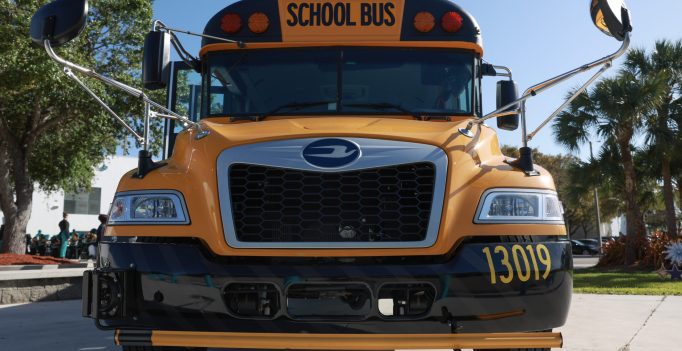Oftentimes, you can hear it—and smell it—before you see it: The steady sputtering of a bright yellow bus rolling around the corner to retrieve kids during the school year.
Each year, school buses around the U.S. carry students more than 4 billion cumulative miles. However, the majority of them are powered by diesel-fueled engines that pre-date the Environmental Protection Agency’s emissions standards.
Along with releasing climate-warming emissions, these diesel engines produce toxic gases such as nitrogen oxides and particulate matter, which can cause an array of health problems; research shows that diesel school buses exacerbate childhood asthma and drive increased reports of pneumonia and bronchitis.
But momentum is building around a federal initiative to clean up schools’ gas-guzzling bus fleets by replacing them with cleaner electric convoys. Today, I am taking you to school to explore this green bus revolution.
Diesel vs. Electric: In 2022, the Biden administration announced the first investments from the EPA’s “Clean School Bus Program,” which was launched to help speed up the electric transition in schools. As of January 2024, the EPA has provided around $1.84 billion to fund 5,103 “clean” school buses—96 percent of them electric—and charging infrastructure at 642 school districts in states, territories and tribal lands, according to a recent report.
Powered by large batteries, electric school buses do not produce any tailpipe emissions. In fact, the EPA says switching even just half of U.S. school buses from diesel to electric could avoid 2.1 million tons of carbon dioxide emissions annually. A large-scale transition to electric vehicles in general would also have widespread benefits for pediatric lung health by reducing asthma attacks and cases of bronchitis, according to a report from the American Lung Association published in February.
The problem? Electric school buses cost around $400,000 each, roughly three to four times as much as diesel-powered buses. That doesn’t factor in the additional tens of thousands of dollars required to build out infrastructure such as electric charging stations. For many school districts, shouldering the cost for this transition alone is impossible, which is why the EPA’s grants and rebates are coming into play.
Though upfront costs are steep, pilot programs show that long-term maintenance costs for electric school buses can be around 44 percent cheaper than diesel buses, and charging is significantly less expensive than traditional fuel.
Electric Equity: In the U.S., many families living below the poverty line do not own a vehicle or are unable to drive their children to school, so the majority of children in these families take the bus instead, according to the U.S. Department of Transportation.
Black, Latino and Indigenous communities are particularly affected by this, making school buses an environmental justice issue because children in these vehicles may be exposed to around four times as much pollution as those in cars. To address this, the “Clean School Bus Program” currently prioritizes low-income, rural or tribal school districts for electric school bus funding.
In March, New York City Mayor Eric Adams announced that schools across the city will receive $61.1 million in federal funds to add 180 new electric school buses to their fleets, with a focus on low-income schools in the Bronx.
“Transitioning NYC school buses to electric and low-emission vehicles is healthier for our kids, our city and the planet,” U.S. Representative Alexandria Ocasio-Cortez said in a statement. “Particularly in the Bronx, which has some of the highest childhood asthma rates in the country, this funding will improve air quality not only for students, but also for communities across the borough.”
In northern Minnesota, Red Lake Schools is one of the first tribal districts to receive electric buses as part of the program, reports E&E News. Its 1,550 students are members of the Ojibwe Tribe.
“We believe underserved kids deserve every opportunity to participate in activities that can open a horizon of new careers for them,” Tim Lutz, the Red Lake School District superintendent, told E&E. “Ultimately, we think this fits with the direction we’re going on sustainability, and the fact that we want to be attuned to clean energy and the natural environment.”
Expanding the Fleet: Advocacy organizations have popped up to help communities tap into federal and state funding for electric school buses, including the Moms Clean Air Force and the Electric School Bus Initiative, which is run by the World Resources Institute (WRI) and the Bezos Earth Fund.
However, some of the districts that have received funding are struggling to get their electric school bus operations off the ground, reports Canary Media. As of November, out of the around 2,300 electric school buses ordered through the EPA program, just 436 had been delivered and are in operation, according to the Electric School Bus Initiative. In many of these cases, districts are still waiting for equipment and charging infrastructure, while other areas require updates to existing infrastructure.
“We’re helping them with fleet planning, helping them with utility engagement,” Alejandra Nuñez, an EPA deputy assistant administrator working on the Clean School Bus Program, said in a webinar with WRI. “We are being very intentional as to how to help school districts to actually implement this, and it’s working well. But we’re learning a lot in the process because a lot of this is new.”
In Illinois, some schools have struggled to get funding due to eligibility criteria, which Aydali Campa wrote about last September for Inside Climate News. However, other districts have overcome these hurdles, including Martinsville Independent School District, a public school district in East Texas that is the first in the state to transition to an all-electric school bus fleet, reports the Texas Tribune. In this case, district administrators fought against skepticism from residents throughout the process who believed the grant would not cover the entire transition, but eventually managed to secure $1.6 million last year that covered the cost of four buses and charging stations.

More Top Climate News
Earlier this week, a record storm ransacked the United Arab Emirates, marking its largest rainfall in 75 years. Flooding has been particularly bad in Dubai, which experienced a year’s worth of rainfall in less than one day during the extreme weather event, reports the New York Times.
At least 20 people were killed by the storm and flooding across the Middle Eastern country as water rose high enough to engulf cars on the street. Scientists convened by the U.N. have said in the past that there is not enough data currently to definitively flesh out the ways that climate change is impacting rainfall in the Arabian Peninsula. But some experts say that warming temperatures related to climate change likely exacerbated this desert rain dump, reports Axios.
Meanwhile, two endangered black-footed ferrets that were successfully cloned from cells frozen in the 1980s were recently born, the U.S. Fish and Wildlife Service announced on Wednesday. This is the second time scientists have cloned this tiny mustelid, of which only around 300 remain in the wild. The effort aims to eventually help rebuild black-footed ferret populations and introduce diversity into their gene pools, which could make them more resilient to environmental threats like climate change, experts say. I wrote more about this and the USFWS’s broader initiative to create a “genetic library” of the country’s endangered species in October if you want to take a deeper dive into the world of ferret clones.









